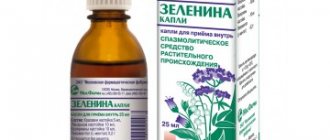Composition and forms
Sinekod is produced in drops for oral administration, specially created for young patients under 3 years of age, and syrup for older children and adults.
The main active ingredient in the drops is butamirate citrate – 5 mg. The secondary components are:
- sorbitol 70%,
- saccharinate;
- benzoic acid;
- ethanol 96%;
- water – 1 ml.
The syrup contains the main active ingredient – butamirate, 1.5 mg per 1 ml. Excipients are:
- sorbitol solution 70%;
- literol;
- benzoic acid;
- ethanol 96%;
- water about 100 ml.
Suction
Based on available data, it is assumed that butamirate ester is rapidly and completely absorbed and hydrolyzed in plasma, turning into 2-phenylbutyric acid and diethylaminoethoxyethanol. The effect of food on absorption has not been studied. The change in the concentration of 2-phenylbutyric acid and diethylaminoethoxyethanol occurs in proportion to the dose taken in the range of 22.5 mg - 90 mg. Butamirate is rapidly and completely absorbed when taken orally, measured concentrations are detected in the blood 5 - 10 minutes after taking doses of 22.5 mg, 45 mg, 1 hour when taking dosages at all 4 levels, the average is 16.1 ng/ml at oral dose of 90 mg.
Average plasma concentrations of 2-phenylbutyric acid are achieved within 1.5 hours; the maximum concentration was observed after a dose of 90 mg (3052 ng/ml); average plasma concentrations of diethylaminoethoxyethanol are reached within 0.67 hours; Cmax is observed after taking a dose of 90 mg (160 ng/ml).
Distribution
Butamirate has a large volume of distribution in the range of 81 - 112 l (adjusted for body weight in kg), as well as a high degree of binding to plasma proteins. 2-phenylbutyric acid has a high degree of binding to plasma proteins at all dosage levels (22.5 - 90 mg), averaging 89.3% - 91.6%. The ability of diethylaminoethoxyethanol to bind to plasma proteins is also detected, the average values vary between 28.8% and 45.7%. It is unknown whether butamirate crosses the placenta or is excreted in breast milk.
Metabolism
Hydrolysis of butamirate, which results in the formation of 2-phenylbutyric acid and diethylaminoethoxyethanol, which have an antitussive effect, occurs very quickly. 2-phenylbutyric acid undergoes further partial metabolism by hydroxylation in the para position.
Removal
Excretion of the three metabolites occurs primarily through the kidneys; After conjugation in the liver, the acidic metabolites are largely bound to glucuronic acid. Conjugates of 2-phenylbutyric acid are detected in urine in significantly higher concentrations than in blood plasma. Butamirate is detectable in urine within 48 hours, and butamirate excreted in urine during the 96-hour sampling period accounts for approximately 0.02, 0.02, 0.03, and 0.03% of 22.5 mg doses. , 45 mg, 67.5 mg and 90 mg, respectively.
As a percentage, butamirate is excreted in the urine in greater quantities in the form of diethylaminoethoxyethanol than unchanged butamirate or unconjugated 2-phenylbutyric acid.
The measured half-lives of 2-phenylbutyric acid, butamirate and diethylaminoethoxyethanol are 23.26-24.42, 1.48-1.93, and 2.72-2.90 hours, respectively.
Mechanism of action
Sinekod is an antitussive drug. It, being a non-opioid drug, suppresses cough. At the same time, it is not addictive and does not form dependence. The effect of taking butamirate is explained by its direct effect on the cough center, as a result of which the cough reflex is suppressed, which occurs both when the mucous membranes of the respiratory tract are irritated and when the cough center itself in the brain is toxic. In addition, the drug has a bronchodilator effect, expanding the lumen of the tubular passages. After administration, breathing becomes easier due to a decrease in the resistance of the lower respiratory tract. Sinekod helps saturate the blood with oxygen.
Sinekod for dry cough, drops for oral administration 20ml
A country
Switzerland
The country of production may vary depending on the batch of goods. Please check with the operator for detailed information when confirming your order.
Active substance
Butamirat
Description
Sinekod drops for dry cough, made in Switzerland, are convenient to dose and give to even the smallest children who suffer from a dry cough.
• Approved for use in children from 2 months of age. • Sinekod facilitates breathing, selectively affecting the cough center • Suppresses cough, having a direct effect on the cough center • Has a bronchodilator effect (dilates the bronchi).* • Reduces the intensity of night cough from the first day of treatment.** * Instructions for medical use, RU P N011631/02 dated 04/22/2011 ** Materazzi F. et al. Gats.med. It. Arch.S.Med. 1984; 143: 229-232.
Compound
Composition per 1 ml: Active ingredient: butamirate citrate - 5 mg. Excipients: sorbitol solution 70% m/m – 405 mg, glycerol – 290 mg, sodium saccharinate – 1.15 mg, benzoic acid – 1.15 mg, vanillin – 1.15 mg, ethanol 96% v/v. – 3 mg, sodium hydroxide 30% m/m – 0.5 mg, water – up to 1 ml.
Product description
Transparent liquid, colorless to colorless with a yellowish tint, with a vanilla odor.
pharmachologic effect
Butamirate is a centrally acting antitussive.
However, the exact mechanism of action of the drug is not known. Butamirate citrate has nonspecific anticholinergic and bronchospasmolytic effects. Suppresses cough, having a direct effect on the cough center. Has a bronchodilator effect (expands the bronchi). Helps make breathing easier by improving spirometry (reduces airway resistance) and blood oxygenation (saturates the blood with oxygen). In therapeutic doses, the drug is well tolerated. Absorption Butamirate is rapidly and completely absorbed when taken orally and is hydrolyzed into 2-phenylbutyric acid and diethylaminoethoxyethanol. The effect of simultaneous food intake on the processes has not been studied. The content of 2-phenylbutyric acid and diethylaminoethoxyethanol in plasma is completely proportional in the dose range of 22.5 - 90 mg. Distribution Butamirate has a volume of distribution between 81 and 112 l (taking into account body weight in kg), as well as a high degree of binding to plasma proteins. 2-phenylbutyric acid has a high degree of binding to plasma proteins in the dose range of 22.5 - 90 mg, with an average value of 89.3 - 91.6%. Diethylaminoethoxyethanol binds to plasma proteins to some extent, with average values ranging from 28.8% to 45.7%. There is no data on the penetration of butamirate through the placental barrier and its excretion in breast milk. Metabolism Hydrolysis of butamirate occurs quickly, the concentrations of metabolites are detected after 5 minutes. Based on these studies, these metabolites are also believed to have antitussive activity, but there are no clinical data on the metabolism of diethylaminoethoxyethanol. 2-phenylbutyric acid undergoes further partial metabolism by hydroxylation at the para position. Excretion 24 hours after taking the drug, the main metabolites (77%) consist of conjugated 2-phenylbutyric acid and parahydroxy-2-phenylbutyric acid. Excretion of 2-phenylbutyric acid, diethylaminoethoxyethanol and p-hydroxy-2-phenylbutyric acid occurs primarily in the urine. The level of 2-phenylbutyric acid conjugate in urine is significantly higher than its level in plasma. Butamirate is detected in the urine within 48 hours after taking the drug orally. The amount of butamirate excreted in the urine over 96 hours corresponds to 0.02%, 0.02%, 0.03% and 0.03% at drug doses of 22.5 mg, 45 mg, 67.5 mg and 90 mg. Butamirate metabolites are excreted in greater quantities. The half-life of butamirate is 1.48-1.93 hours, 2-phenylacetic acid is 23.26-24.42 hours, diethylaminoethoxyethanol is 2.72-2.90 hours. Special groups of patients There are no data on changes in the pharmacokinetics of the drug in patients with impaired liver or kidney function.
Indications for use
Symptomatic treatment of dry cough of various etiologies.
Contraindications
Hypersensitivity to the components of the drug; — Children up to 2 months; — Pregnancy (first trimester) and breastfeeding period; — Hereditary fructose intolerance, because the drug contains sorbitol. - Simultaneous use with expectorants.
Carefully
Pregnancy (II and III trimesters); — In patients with a tendency to develop drug dependence, because the drug contains ethanol; — Impaired liver function; — Alcoholism; — Epilepsy; — Brain diseases; — Use in children under 2 years of age. If you have any of the listed diseases/conditions/risk factors, you should consult your doctor before taking the drug.
Use during pregnancy and lactation
Pregnancy There is insufficient data on the use of the drug in pregnant women. In animal studies, no adverse effects on pregnancy or fetal health were observed. The use of the drug during pregnancy is possible only after consultation with a doctor, provided that the benefits to the mother outweigh the possible risks to the fetus. In this case, the minimum effective dose should be used for the shortest possible period of time. Breastfeeding period There is not enough data on the excretion of butamirate into breast milk. The use of the drug during breastfeeding is possible only after consultation with a doctor, provided that the benefits to the mother outweigh the possible risks to the child. In this case, the minimum effective dose should be used for the shortest possible period of time.
Directions for use and doses
For oral administration. Do not exceed the recommended dose! The smallest dose required to achieve the effect should be used for the shortest possible period of time! The maximum duration of use of the drug without consulting a doctor is 7 days. Adults and children over 3 years of age: 25 drops (6.25 mg) 4 times a day. The maximum daily dose is 100 drops (25 mg). Children aged 1 to 3 years: 15 drops (3.75 mg) 4 times a day. The maximum daily dose is 60 drops (15 mg). Children aged 2 months to 1 year: 10 drops (2.5 mg) 4 times a day. The maximum daily dose is 40 drops (10 mg). Special groups of patients Children under 2 years of age In patients of this age category, the drug can only be taken after consultation with a doctor. If symptoms worsen or do not improve after 7 days of treatment, as well as if there is a fever, rash or persistent headache, you should consult a doctor for further examination.
Side effect
Adverse reactions are classified according to body systems and according to the frequency of development. The frequency of adverse reactions is determined as follows: very often (≥ 1/10), often (≥ 1/100 and 0 and Disorders of the skin and subcutaneous tissues: Rarely: urticaria, possible development of allergic reactions. Disorders of the gastrointestinal tract : Rare: nausea, diarrhea Nervous system disorders: Rare: drowsiness
Overdose
Symptoms: Drowsiness, nausea, vomiting, diarrhea, dizziness and decreased blood pressure. Treatment There is no special antidote. In case of overdose, you should do a gastric lavage, take activated charcoal and support the vital functions of the body.
Interaction with other drugs
No drug interactions have been reported for butamirate. Due to the fact that butamirate suppresses the cough reflex, the simultaneous use of expectorants should be avoided to avoid the accumulation of sputum in the respiratory tract with the risk of developing bronchospasm and respiratory tract infection.
special instructions
The drops contain saccharinate and sorbitol as sweeteners, so they can be prescribed to patients with diabetes. The drug contains a small amount of ethyl alcohol (2.81 mg/ml), less than 100 mg per dose. Due to the presence of ethyl alcohol in the drug, use with caution in patients with a tendency to develop drug dependence, with liver diseases, alcoholism, epilepsy, brain diseases, in pregnant women and children. The drug contains less than 1 mmol sodium per dose.
Release form
Oral drops [for children] 5 mg/ml. 20 ml in a dark glass bottle, equipped with a dropper - a dispenser made of low-density polyethylene and a polypropylene cap, equipped with a first-opening control system. 1 bottle along with instructions for use is placed in a cardboard box. Secondary packaging may have a first-opening control.
Storage conditions
Store at a temperature not exceeding 30 C. Keep out of reach of children.
Best before date
3 years. Do not use after the expiration date stated on the packaging.
Interaction
Sinekod does not interfere with the absorption of antibiotics and does not affect their concentration in the blood. However, it should not be taken simultaneously with mucolytic and expectorant drugs that produce sputum. Simultaneous use of the drug Sinekod with expectorants and mucolytic drugs will lead to pneumonia of bacterial etiology, since the removal of sputum will be impossible due to suppression of the functions of the cough center. The mucus produced will not be coughed out, but will instead begin to accumulate in the lungs, causing bacteria to multiply.
Sinekod
Sinecode (active ingredient - butamirate) is an original drug for the symptomatic treatment of dry cough of a wide variety of etiologies. Cough is a protective reaction of the body that occurs when receptors in the respiratory tract are irritated. In most cases, it indicates the presence of some disease, most often the respiratory system. Adequate pharmacotherapy of cough is the most important task facing modern medicine. After determining the exact cause of the cough, treatment of the underlying disease begins, which is supported by taking medications for symptomatic therapy, the action of which can be aimed both at suppressing the cough and at increasing its productivity (mucoactive drugs). Suppression of the cough reflex is required in cases of dry, non-productive cough that does not fulfill its cleansing function. Such a cough significantly worsens the quality of life of patients and can threaten hemodynamic disturbances in the thoracic region, vomiting, hemoptysis, and diaphragmatic hernia. Medicines that inhibit the cough reflex can affect the cough center (central action) or the sensitivity of cough receptors (peripheral action). Among the first, a distinction is made between narcotic and non-narcotic drugs. Moreover, despite all the effectiveness of narcotic drugs, their use is associated with many undesirable side reactions. A significant advance in the treatment of dry cough has been the creation of new centrally acting antitussive drugs, comparable in effectiveness to narcotic drugs, but without such a severe side effect. Of significant interest in this aspect is the centrally acting antitussive drug Sinecode from the Swiss pharmaceutical corporation Novartis. In terms of its chemical structure and pharmacological “habits,” the active substance of sinecode, butamirate, in no way resembles opium alkaloids. Unlike morphine derivatives, the effect of butamirate on the cough center is selective, due to which sinecode is devoid of sedative and analgesic effects, does not cause pathological dependence and does not depress the respiratory center.
The effectiveness of the drug does not decrease even with long-term treatment, and the peak of its effect is achieved after the first use. In comparison with other drugs of this pharmacological group, Sinecode is endowed with a number of advantages, the main of which are high efficiency, favorable safety profile and good tolerability. Clinical trials have shown that the drug causes virtually no unwanted side effects even after long-term use: only in rare cases can skin rashes, dyspeptic disorders and dizziness occur. As already mentioned, sinecode can be used for non-productive cough of any etiology, as well as for cough center hypersensitivity syndrome that occurs as a consequence of a previous respiratory disease. The drug not only reliably blocks all “body movements” of the cough center, but also exhibits an anti-inflammatory and expectorant effect, dilates the bronchi, reduces the resistance of the respiratory tract and promotes oxygen saturation of the blood. Clinical studies have demonstrated the effectiveness of sinecode against both new-onset and chronic debilitating dry cough. The drug is characterized by a pronounced, long-lasting and rapid therapeutic effect, which begins to manifest itself already 1 hour after administration (in which it is clearly superior to codeine-containing drugs). Butamirate is quickly and completely absorbed in the gastrointestinal tract. Its half-life is 6 hours. Not only butamirate itself has an antitussive effect, but also its metabolites formed in the blood.
Sinekod is available in two dosage forms: drops for oral administration and syrup. The drops are used in pediatric practice, starting from 2 months, and the syrup is indicated for adults and children from 3 years of age.
Dosage
The drug does not treat dry cough, but only temporarily relieves the symptom. It is advisable to take the drug strictly at night to get rid of an irritating sensation in the respiratory tract, a suffocating cough that interferes with sleep. It should be remembered that cough is a symptom of illness, not a disease. Only by getting rid of the cause (bacterial, fungal or viral infection, allergen, toxins) causing the cough can you forget about the unpleasant symptom.
A single dose for syrup is:
- children from 3 to 6 years old – 5 ml;
- children from 6 to 12 years old – 10 ml;
- children over 12 and adults – 15 ml.
A course of taking the drug for several days or even weeks is possible for severe forms of whooping cough. In this case, the dosage and duration of administration are determined by the attending physician. Drops are taken in the following volumes:
- children of the first year of life are given up to 10 drops at a time;
- children from one to 3 years old – 15 drops per dose;
- For children over 3 years of age, a single dose is increased to 25 drops.
Overdose
If you take the drug excessively, the following side effects are possible:
- drowsiness;
- weakness;
- nausea;
- diarrhea;
- skin rashes.
At the first signs of drug poisoning, you should immediately stop taking it and perform gastric lavage. In severe cases, sorbents are taken to speed up the removal of absorbed substances from the blood. Further treatment should be discussed with your doctor to replace Sinekod with an analogue or stop symptomatic therapy.



